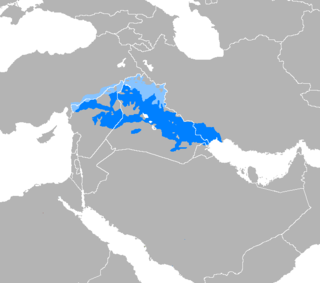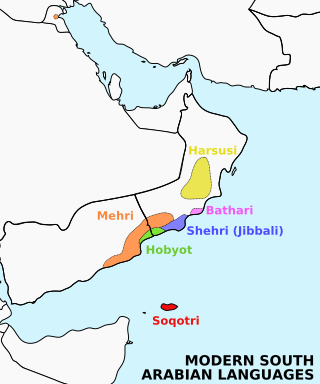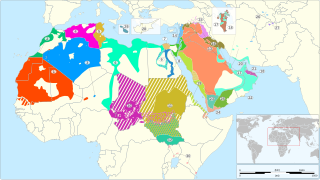
Najd is the central region of Saudi Arabia, in which about a third of the country's modern population resides. It is the home of the House of Saud, from which it pursued unification with Hejaz since the time of the Emirate of Diriyah.

The Eastern Province, also known as the Eastern Region, is the easternmost of the 13 provinces of Saudi Arabia. It is the nation's largest province by area and the third most populous after the Riyadh and Mecca provinces. In 2017, the population was 4,900,325. Of these, 3,140,362 were Saudi citizens and 1,759,963 were foreign nationals The province accounts for 15.05% of the entire population of Saudi Arabia and is named for its geographical location relative to the rest of the kingdom.

Yemeni Arabic is a cluster of varieties of Arabic spoken in Yemen and southwestern Saudi Arabia. It is generally considered a very conservative dialect cluster, having many classical features not found across most of the Arabic-speaking world.

Gulf Arabic is a variety of the Arabic language spoken in Eastern Arabia around the coasts of the Persian Gulf in Kuwait, Bahrain, Qatar, the United Arab Emirates, southern Iraq, eastern Saudi Arabia, northern Oman, and by some Iranian Arabs.

Mesopotamian Arabic or Iraqi Arabic is a group of varieties of Arabic spoken in the Mesopotamian basin of Iraq, as well as in Syria, Kuwait, southeastern Turkey, Iran, and Iraqi diaspora communities.
Gimel is the third letter of the Semitic abjads, including Phoenician gīml 𐤂, Hebrew gīmel ג, Aramaic gāmal 𐡂, Syriac gāmal ܓ, and Arabic ǧīm ج. Its sound value in the original Phoenician and in all derived alphabets, except Arabic, is a voiced velar plosive ; in Modern Standard Arabic, it represents either a or for most Arabic speakers except in Northern Egypt, the southern parts of Yemen and some parts of Oman where it is pronounced as the voiced velar plosive.

Mehri or Mahri (مهريّت) is the most spoken of the Modern South Arabian languages (MSALs), a subgroup of the Semitic branch of the Afroasiatic family. It is spoken by the Mehri tribes, who inhabit isolated areas of the eastern part of Yemen, western Oman, particularly the Al Mahrah Governorate, with a small number in Saudi Arabia near the Yemeni and Omani borders. Up to the 19th century, speakers lived as far north as the central part of Oman.
The Bahārna are an ethnoreligious group of Shia Muslim Arabs indigenous to the historical region of Bahrain. They are generally regarded to be the original inhabitants of Eastern Arabia. They inhabited the area even before the arrival of the Banu Utbah in the 18th century which the Bahraini royal family descends from. Most Bahraini citizens are Baharna. Regions with most of the population are in Eastern Arabia, with significant populations in Kuwait, United Arab Emirates, Qatar, Oman, Iraq, and Hormozgan province of Iran.

Bahrani Arabic is a variety of Arabic spoken by the Baharna in Eastern Arabia and Oman. In Bahrain, the dialect is primarily spoken in Shia villages and some parts of Manama. In Saudi Arabia, the dialect is spoken in the governorate of Qatif. In Oman, it is spoken in the governorates of Al Dhahirah and Al Batinah.

Najdi Arabic is the group of Arabic varieties originating from the Najd region of Saudi Arabia. Outside of Saudi Arabia, it is also the main Arabic variety spoken in the Syrian Desert of Iraq, Jordan, and Syria as well as the westernmost part of Kuwait.

Hejazi Arabic or Hijazi Arabic (HA), also known as West Arabian Arabic, is a variety of Arabic spoken in the Hejaz region in Saudi Arabia. Strictly speaking, there are two main groups of dialects spoken in the Hejaz region, one by the urban population, originally spoken mainly in the cities of Jeddah, Mecca, Medina and partially in Ta'if and another dialect by the urbanized rural and bedouin populations. However, the term most often applies to the urban variety which is discussed in this article.

The Hejazi turban, also spelled Hijazi turban, is a type of the turban headdress native to the region of Hejaz in modern-day western Saudi Arabia.

Omani Arabic is a variety of Arabic spoken in the Al Hajar Mountains of Oman and in a few neighboring coastal regions. It is the easternmost Arabic dialect. It was formerly spoken by colonists in Kenya and Tanzania, but these days, it mainly remains spoken on the island of Zanzibar.

The Emiratis are the native citizen population of the United Arab Emirates. Within the UAE itself, they number approximately 1.15 million.
Bedouin Arabic refers to a typological group of Arabic dialects historically linked to Bedouin tribes, that has spread among both nomadic and sedentary groups across the Arab World. The group of dialects originate from Arabian tribes in Najd and the Hejaz that have spread since the 10th century until modern day. Bedouin dialects vary by region and tribe, but they typically share a set of features which distinguish them from sedentary-type dialects in each region.

Varieties of Arabic are the linguistic systems that Arabic speakers speak natively. Arabic is a Semitic language within the Afroasiatic family that originated in the Arabian Peninsula. There are considerable variations from region to region, with degrees of mutual intelligibility that are often related to geographical distance and some that are mutually unintelligible. Many aspects of the variability attested to in these modern variants can be found in the ancient Arabic dialects in the peninsula. Likewise, many of the features that characterize the various modern variants can be attributed to the original settler dialects as well as local native languages and dialects. Some organizations, such as SIL International, consider these approximately 30 different varieties to be separate languages, while others, such as the Library of Congress, consider them all to be dialects of Arabic.

Jordanian Arabic is a dialect continuum of mutually intelligible varieties of Arabic spoken by the population of the Hashemite Kingdom of Jordan.
Mashriqi Arabic, or Mashriqi ʿAmmiya, encompasses the varieties of Arabic spoken in the Mashriq, including the countries of Egypt, Lebanon, Palestine, Kuwait, Jordan, Syria, Cyprus, Turkey, Iraq, Sudan, Saudi Arabia, UAE, Oman, Bahrain and Qatar. The variety is sometimes referred to as Eastern Arabic, as opposed to Western Arabic and includes Mesopotamian Arabic and Peninsular Arabic, along with Egyptian Arabic, Sudanese Arabic, and Levantine Arabic. Speakers of Mashriqi call their language ʿAmmiya, which means "common or colloquial" in Modern Standard Arabic.
Pre-classical Arabic is the cover term for all varieties of Arabic spoken in the Arabian Peninsula until immediately after the Arab conquests and emergence of Classical Arabic in the 7th century C.E. Scholars disagree about the status of these varieties.
Gilit Mesopotamian Arabic, also known as Iraqi Arabic, Mesopotamian Gelet Arabic, or simply Mesopotamian Arabic is one of the two main varieties of Mesopotamian Arabic, together with North Mesopotamian Arabic.















